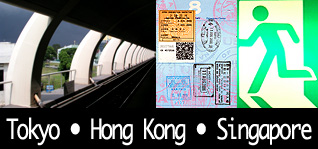
Japan
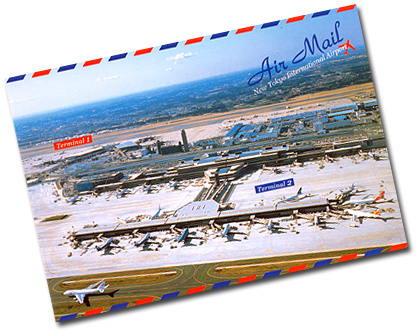
Departing San Jose on
a Tuesday afternoon, I arrive in Narita Airport at about 4 p.m. on Wednesday
- eleven hours later, thanks to that crazy international date line. Narita serves
as the standard waystation for international travelers visiting or passing through
Tokyo. Well designed for long-term stays, Narita includes plenty of amenities
for travelers planning to spend more than an hour within its confines: meeting
rooms, dayrooms, internet cafes, massage chairs, and "media rooms"
for watching movies. The terminal is kept scrupulously clean and is well guarded
by patrolling security personnel. As I depart the plane, I am buzzed with excitement.
I have no clue where I’ll sleep or what I’ll do today. Happily,
I quickly find a tourist desk and am directed to a nearby hotel where reservations
are easily secured. I catch the shuttle and enjoy an evening of rest from the
long trip. Next morning, I catch another shuttle for the airport and plan my
Tokyo excursion.
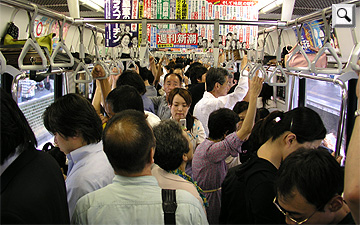 Narita
resides far from the heart of Japan's capital city, in a different prefecture,
in fact. While Tokyo International Airport lies nearer to the city, it concentrates
on domestic and cargo traffic more than international traffic. I note this with
some amusement and annoyance. While train lines that run directly from Narita
to mammoth (and astoundingly complex) Tokyo Station depart directly from the
airport, the fastest of these takes about an hour and costs a bundle. Oddly
enough, this is an improvement over the previous era when visitors were forced
to take shuttle buses to more distant train stations connecting to downtown
Tokyo. The airport awaits the opening of the Narita Rapid Railway in 2010. In
the meantime, most visitors to bypass more pricy trains with their reserved
seating and more direct routes and take the Kaisoku Airport Narita Train instead.
During rush hour, this means up to an hour and a half of strap-hanging if you
don't snag a seat early or if you choose to abandon yours for elderly or infirmed
travelers. I give up my seat going both directions. The feeling of a good deed
lasts a while, but I must admit that the trips stretch quite a bit beyond that
point.
Narita
resides far from the heart of Japan's capital city, in a different prefecture,
in fact. While Tokyo International Airport lies nearer to the city, it concentrates
on domestic and cargo traffic more than international traffic. I note this with
some amusement and annoyance. While train lines that run directly from Narita
to mammoth (and astoundingly complex) Tokyo Station depart directly from the
airport, the fastest of these takes about an hour and costs a bundle. Oddly
enough, this is an improvement over the previous era when visitors were forced
to take shuttle buses to more distant train stations connecting to downtown
Tokyo. The airport awaits the opening of the Narita Rapid Railway in 2010. In
the meantime, most visitors to bypass more pricy trains with their reserved
seating and more direct routes and take the Kaisoku Airport Narita Train instead.
During rush hour, this means up to an hour and a half of strap-hanging if you
don't snag a seat early or if you choose to abandon yours for elderly or infirmed
travelers. I give up my seat going both directions. The feeling of a good deed
lasts a while, but I must admit that the trips stretch quite a bit beyond that
point.
I exit onto one of the many, many platforms of Tokyo Station. Immediately, I
learn that this city's interconnecting trains, subways, and buses create a tangle
of routes as complex as the one I experienced in New York City. And, of course,
not knowing the language, I must learn quickly the meanings of various icons
placed to guide me. One symbol, a man racing through a door, looks positively
ominous, particularly with the green shadow extending
from his leg. Before long, I reason (before reading the tiny English script)
that this sign means "exit." More than any other sign, knowing where
to exit marks freedom within omnitopia. Here I recall wandering the floors and
walkways and passages of interconnected Las Vegas hotels, sensing that I may
never escape this enclosure. The dearth of windows and the lack of natural light
creates a claustrophobia that may be compared to residents of a maximum-security
prison. But seeing the running man, his green shadow reminding me of a mid-century
detective book, offers me the path outside.
Exiting, I enter a punishing wave of summer broil. The buildings and vast roadways
reflect the heat in shimmering waves, and I have no place to go. As I noted
before, I have taken this journey to encounter "tourist flow," the
invisible current that leads the stranger from place to place. Checking my spelling
of the word, "current," I notice for the first time that the same
word refers to both the flowing movement of liquid or air and, at the same time,
the existence of something "in the moment." The moment exists now
and as flow simultaneously. I resolve to explore this further, but at the moment,
I seek some direction. Before too long, I find a sign meant for tourists; it
features a map, Japanese and English place descriptions, distances in meters,
and even a "you are here" notation. At last, I have some orientation.
Better yet, I discover that I'm standing near the Imperial Palace. I find small
trickles of walkers gathering toward a direction that leads us to the Meganebashi
Bridge. It seems appropriate that my first tourist excursion around the
edges of omnitopia in Tokyo will be a bridge. The site itself is underwhelming
because I lack the cultural knowledge to interpret this sign system. There are
delicately manicured trees, there is an obscured pagoda-style building, and
there are serious looking guards protecting the driveway. But I have no reference
for these images. Behind me a tour bus begins to disgorge an international array
of tourists, each studying their guidebooks and readying their cameras. I take
a couple of pictures and make my way back downtown.
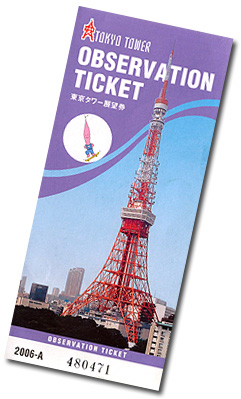 Returning
to the subway, I head in the general direction of Tokyo
Tower, an Eiffel Tower look-alike that seems to encapsulate much of Japan’s
complicated relationship with the West. For most visitors, the Tower offers
a refreshing break from the city’s heat and a chance to catch a dazzling
view of the surrounding city. After taking an elevator
to the lower observation deck, I join a queue of children waiting to stand on
the reinforced glass bottom, where my feet seem to hang
in mid-air. I then circle the length of the lower observation deck, amazed
by the expanse of this massive city. Eventually, I take the elevator back down
and wander back near the Zojoji Temple. The trees in the surrounding Shiba Park
seem to be filled with shrieking insects that resemble locusts. I stop to locate
one of the bugs and am amazed that such a loud noise comes from such a small
creature. I walk a bit closer and the thing jumps toward me, flying to a nearby
tree. Shrieking bugs I can handle, but when this thing takes flight I nearly
leap out of my clothes. Nearby a boy and his mother stare at another bug that
chatters in a similarly high pitch. The boy walks closer toward a tree and cups
one of the creatures with his hand before handing it to his mom, to my utter
astonishment. He holds the thing like a toy. He then turns to me and motions
a question, “would I like to hold the bug?” My pained attempt at
a courteous “no” needs no translation.
Returning
to the subway, I head in the general direction of Tokyo
Tower, an Eiffel Tower look-alike that seems to encapsulate much of Japan’s
complicated relationship with the West. For most visitors, the Tower offers
a refreshing break from the city’s heat and a chance to catch a dazzling
view of the surrounding city. After taking an elevator
to the lower observation deck, I join a queue of children waiting to stand on
the reinforced glass bottom, where my feet seem to hang
in mid-air. I then circle the length of the lower observation deck, amazed
by the expanse of this massive city. Eventually, I take the elevator back down
and wander back near the Zojoji Temple. The trees in the surrounding Shiba Park
seem to be filled with shrieking insects that resemble locusts. I stop to locate
one of the bugs and am amazed that such a loud noise comes from such a small
creature. I walk a bit closer and the thing jumps toward me, flying to a nearby
tree. Shrieking bugs I can handle, but when this thing takes flight I nearly
leap out of my clothes. Nearby a boy and his mother stare at another bug that
chatters in a similarly high pitch. The boy walks closer toward a tree and cups
one of the creatures with his hand before handing it to his mom, to my utter
astonishment. He holds the thing like a toy. He then turns to me and motions
a question, “would I like to hold the bug?” My pained attempt at
a courteous “no” needs no translation.
Later in the afternoon, I make my way to the Ginza District, an international
cross-section of high-end shopping, people-watching, and media saturation. Despite
wearing decent shoes and socks, my feet ache and the sweat of high summer has
inspired a most unfortunately placed rash. I walk bowlegged but determined.
Wandering the streets, studying billboards, or simply pausing to watch television,
I am astounded at the proliferation of childlike characters and other cartoonish
components. On video monitors, I gasp at the near-constant integration of videogame
inspired sound effects, dancing anthropomorphic graphics, and colorful mascots.
Add to this mix the saucer-shaped eyes found in anime characters, the seemingly
endless number of Hello Kitty charms hanging from mobile phones, and of course
the ever-presence of young girls dressed in school or sailor attire (not to
mention their ubiquitous appearance in more sexualized form in various media),
and the visitor to Japan can be forgiven for thinking that this nation is overrun
by a "culture of cute."
Of course, mine is hardly a new realization about his culture. Many observers
of Japanese culture - or more accurately the nation's convergence of pop and
business culture - have noted this obsession with childlike imagery. A most
compelling rationale for the "culture of cute," at least to an outsider
such as myself, is that Japanese young people have little enthusiasm for adult
life in their country. The stifling conformity, the strangling economy, the
collapsing social contract of lifelong employment: these exigencies remind some
observers of the "no future" punk aesthetic. The only difference is
that many youth and young adults choose to attach Hello Kitty toys to their
mobile phones rather than rip their shirts with razor blades.
I am also struck by the continuous appearance of English words in seemingly
random places and overheard conversations. I recall years ago the stories of
visitors to Japan who laughed about t-shirts sporting nonsensical English words,
as if the mere appearance of words associated with the United States or Europe
would lend some degree of coolness to the wearer. These days of globalization
have helped ensure that the designers of Japanese t-shirts are far more likely
to compose slogans that make some sense. But there's no guarantee for complete
accuracy. One particularly memorable example, from a girl riding the train from
Tokyo: "Cats in gloves catches no mice." I've had hours to think about
these words but the meaning of this particular phrase continues to elude me.
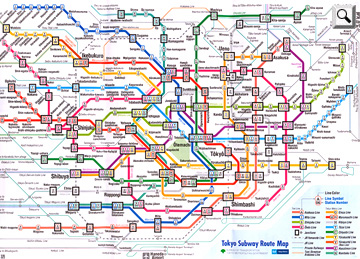 For
me, Tokyo exists as an unbelievably complex subway and train system that I never
manage to master, exactly. I make my way from stop to stop and figure that even
being lost in Japan’s capital city is still pretty cool. When I manage
to accomplish some small goal - getting onto the right subway line, using the
right change to buy a newspaper, or even receiving a tasty beverage from one
of the city's ubiquitous vending machines - I inwardly exclaim (with some guilt)
a line from The Simpsons uttered by a pachinko machine "You a
winner! Ha, Ha, Ha! You a winner! Ha, Ha, Ha!"
For
me, Tokyo exists as an unbelievably complex subway and train system that I never
manage to master, exactly. I make my way from stop to stop and figure that even
being lost in Japan’s capital city is still pretty cool. When I manage
to accomplish some small goal - getting onto the right subway line, using the
right change to buy a newspaper, or even receiving a tasty beverage from one
of the city's ubiquitous vending machines - I inwardly exclaim (with some guilt)
a line from The Simpsons uttered by a pachinko machine "You a
winner! Ha, Ha, Ha! You a winner! Ha, Ha, Ha!"
Before long, I return to Narita and the omnitopian continuum. I write much of
this while managing a low-grade fever. Naturally I worry about the consequences
of getting seriously ill while overseas. My schedule is tight and I can hardly
afford much downtime spent vomiting in a toilet. Thus far, my body temperature
has not escalated far beyond the "is it hot here, or is it me?" stage.
So at this point I can relish in romantic, even heroic, imagery of the fever-struck
foreigner sitting at a table on the dusty streets of some far-off city, nursing
an ill-advised alcoholic beverage and enduring the stuporous heat. Yet, as I
write this, I am sitting on a Japan Airlines plane, heading for Hong Kong, hot
coffee and green tea is freely flowing, and the in-flight movie is Robin Williams'
road trip flick, RV. So while I watch a film depicting well-healed
suburbanites heading for the wilderness, I can hardly claim to experience much
real danger myself.
| Back |